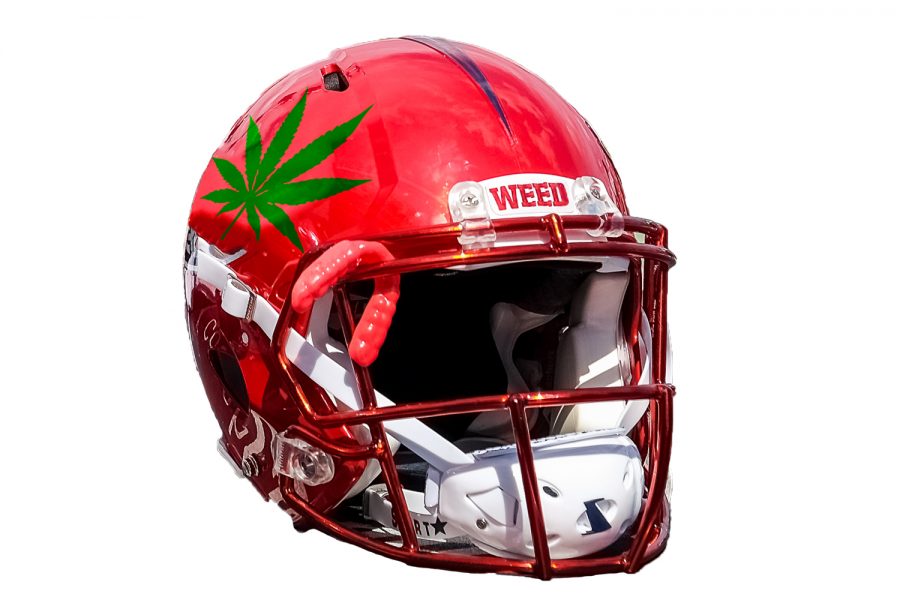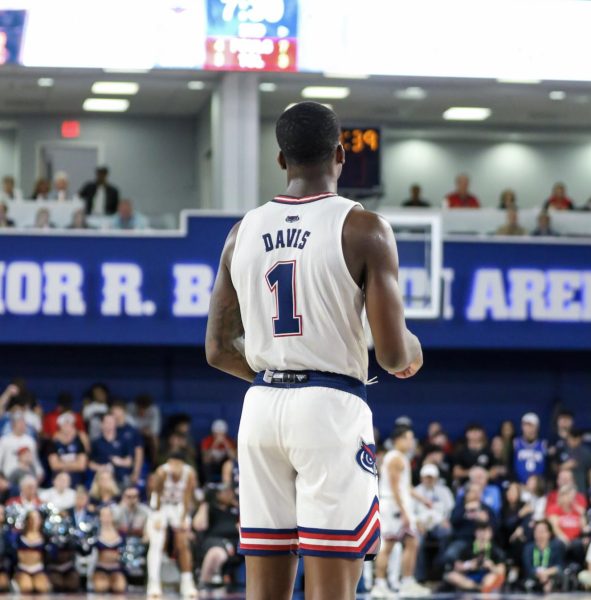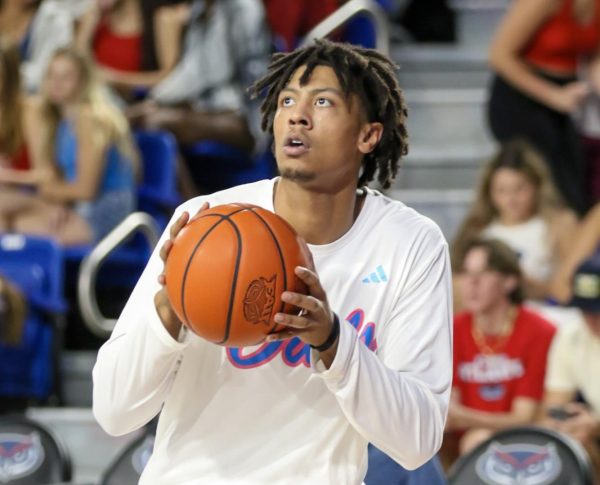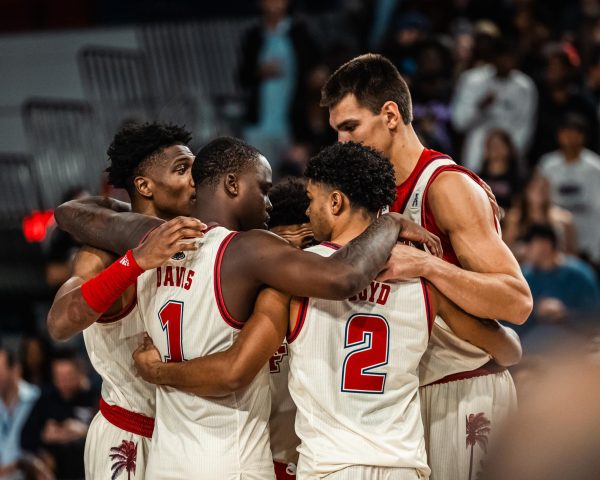Opinion: Cannabis could help prevent long-term damage from concussions
Marijuana could be the answer to football’s concussion treatment problem.
September 8, 2016
Correction: The previous print edition ( volume 18, issue two) of this article had an editing error in the “What is CTE” sidebar. The error stated 321 American football players died as a result of CTE when not all had the disease confirmed. Twelve of the 321 brains underwent studies, all of which came back positive for CTE.
The violent yet poetic nature of football pulls fans back like the hankering a heavy smoker gets for a cigarette.
One may struggle to ignore nicotine’s temptation, while fans have to be pried away from their television screens every fall and winter weekend.
However the similar, powerful addiction each can hold over a person pales in comparison to the connection Dr. Bennet Omalu — the man who discovered chronic traumatic encephalopathy and the inspiration for the character Will Smith played in the movie “Concussion” — made between football and cigarettes when he spoke at Florida Atlantic’s Jupiter campus in March.
Some people can smoke cigarettes and never become sick, while others are not so lucky. This creates an interesting dynamic as the number of cigarettes needed to harm one’s health can differ from person to person.
In football, like with the unpredictability of cigarette harm, no one knows how many blows to the head it takes to create enough trauma to cause CTE, or any other permanent damage.
What we do know, according to an NCAA self-reported study from February 2014, is that 17.9 percent of college football players will suffer at least one concussion during their collegiate career, with 9.5 percent suffering from multiple in that span.
While those percentages may seem high enough already, they can still be misleadingly low, as only one out of every 27 head injuries are reported, according to a study by Harvard University and Boston University relayed by ESPN in October 2014.
Concussions aren’t the only path to CTE.
Boston University reports that subconcussive hits that cause no concussion-like symptoms can lead to the disease as well. According to Frontline, “It’s the repeat, more minor head trauma that occurs regularly in football that may pose the greatest risk to players.”
With the combination of the repetitive minor blows, as well as the car crash collision-like concussions, the NFL “expects nearly a third of retired players to develop long-term cognitive problems and that the conditions are likely to emerge at ‘notably younger ages’ than in the general population,” according to the New York Times.
No helmet or padding can prevent this from happening, as the brain sits in the skull, unattached and capable of being jostled against the skull walls. CTE also can’t be diagnosed until an autopsy, making it next to impossible to know if one is living with the disease.
But what if there was a pre-emptive action available that offered minimal, if any, adverse side effects?
Surely the NFL and NCAA would take any measure to simultaneously protect the sanctity of football and the players’ health.
What if that same possible protectant happened to be marijuana, a substance illegal in the majority of the United States?
There are 512 different chemicals in cannabis, according to Dr. David Bearman, vice president of the American Academy of Cannabinoid Medicine who has served in multiple government drug abuse jobs, including Gov. Ronald Reagan’s Inter Agency Task Force on Drug Abuse.
Of the 512 chemicals, 80-100 are unique to cannabis. These cannabinoids — such as cannabidiol, or CBD, and THC, the chemical which induces the psychoactive high — contain many medical benefits, including the ability to act as a neuroprotectant.
In fact, the U.S., as represented by the Department of Health and Human Services owns United States patent 6,630,507, which states the following:
“Cannabinoids are found to have particular application as neuroprotectants, for example in limiting neurological damage following ischemic insults, such as stroke and trauma, or in the treatment of neurodegenerative diseases.”
When the brain is injured, three main processes lead to spreading brain damage that becomes permanent, said Dustin Sulak, medical director for Integr8 Health in Maine. Those are the swelling of the brain, the damaging of neurons and the damaging of molecules.
CBD limits all three of these damaging processes “unlike most pharmaceuticals” which target just one specific problem, Sulak said.
“THC also has profound neuroprotective effects that in many cases are more powerful than those of CBD, but the best results are achieved by using the combination,” Sulak continued.
According to a study from the Los Angeles Biomedical Research Institute, patients with traumatic brain injury who also tested positive for THC had a significantly lower mortality rate.
The study included 446 patients who suffered traumatic brain injuries and underwent a urine test for the presence of THC in their system, which 82 patients tested positive for. Of those 82 patients who tested positive for THC, only 2.4 percent died, whereas 11.5 percent of the patients without THC in their systems died.
When CBD is administered with THC, it reduces its psychoactive effects. Therefore a person could take the combination of the two chemicals, protecting the brain without any impairment or euphoria.
According to Sulak, in the case of football players, the cannabinoids would be best consumed prior to the injury, however it would still be effective post injury.
“If CBD were present in the brain at the time of the injury, instead of administered 15-30 minutes later, the beneficial effects would likely be even more profound,” Sulak said.
“Since CBD has other beneficial properties desired by professional athletes, such as pain and anxiety relief, and enhanced healing of injured muscle and bone, it would certainly make sense to take CBD for prevention before an injury. Even if it were only used to treat concussion after the fact, it would likely improve the long term outcomes in these cases.”
Former first-round draft pick Eugene Monroe, who is a free agent with seven seasons of NFL experience, is currently advocating for medical marijuana use in the NFL.
“I’m calling for the NFL to remove marijuana from the banned substances list; fund medical marijuana research, especially as it relates to CTE; and stop overprescribing addictive and harmful opioids,” reads his website, which is dedicated to educating the public on medical marijuana.
Other former NFL players, including Pro-Bowl quarterback Jake Plummer and two-time Super Bowl champion quarterback Jim McMahon have gone on record stating how their individual healths, which have deteriorated thanks to their respective football careers, have improved after using medical marijuana.
Bearman continued to say that studies that report adverse effects in the brain are poorly done, including the study which first alleged that cannabis causes brain damage performed by Robert Heath of Tulane University.
In the study, according to Bearman, a scientist exposed monkeys to marijuana smoke and was disappointed that he didn’t find any particular negative effects.
He said they were not getting enough marijuana smoke and therefore gave each of them a gas mask, which is when he discovered brain damage in monkeys.
“What happens when you do that is there’s something you don’t give the monkeys, and that’s oxygen,” Bearman said. “So when they sacrificed the monkeys and looked at the brains, they had brain damage. But the brain damage was not from smoking marijuana, the brain damage was from not getting oxygen … You just really don’t have any studies that have any validity at all that demonstrate an adverse effect of the human brain from the use of cannabis.”
In fact, the National Institute on Drug Abuse gave Donald Tashkin — a professor of pulmonology at the University of California, Los Angeles — a grant to conduct a study whether or not marijuana causes cancer in the lungs. Tashkin concluded there is no as association between the regular smoking of marijuana and lung cancer.
Currently, the NCAA penalty for the use of marijuana, and any other recreational drug, is a six-month suspension, which is a decrease compared to the previous penalty of one year.
While the NCAA is becoming more lenient on marijuana use, no plans have been announced regarding medicinal use. It was unable to be reached as of publication time.
Florida Amendment Two — a new law change which proposes to regulate marijuana production and distribution for people with specific debilitating diseases or comparable debilitating conditions — will be on this November’s ballot. This means schools like FAU could be in legal medical marijuana territory, yet its players will still be unable to benefit from its effects.
“What’s sad to me is that we ask questions about cannabis that we don’t about other medications,” Bearman said. “We know that we have a medicine that the American Medical Association, in 1937 in their testimony against the Marijuana Tax Act, said that they knew of no dangers to the medicinal use of cannabis. Then we ought to be giving it to [players] before football games in order to limit the danger, the damage that we know is caused by concussions.”
In the meantime, the NCAA has attempted to help reduce concussion rates without the help of cannabis. According to FAU head football coach Charlie Partridge, there has been a lot of change.
“A lot of us around the country changed the way we teach tackling, so that’s a huge change for us,” he said. “And the way you teach hitting, you used to teach players to get their head across the ball carrier’s body and you do more tackling with the shoulder to the thigh level so that has changed a lot … We as coaches have been educated more on what to look for on how long it’s going to take someone to recover once someone has been identified with a concussion.”
The team also travels with a spotter — someone who is with them every game day. The spotter’s sole job is to watch for someone who has symptoms of a concussion.
“I absolutely believe CBD could help the current situation and make a big difference in the long-term outcomes for players,” Sulak said.
Most schools including FAU have concussion protocols in place. The only problem with the protocols, as well as the improvements the game has made, is the fact that they aren’t doing anything to counter the damage that the brain trauma creates.
What is CTE?
According to Boston University, chronic traumatic encephalopathy is a progressive degenerative disease found in the brain of people “with a history of repetitive brain trauma, including symptomatic concussions as well as asymptomatic subconcussive hits to the head.”
“The brain degeneration is associated with memory loss, confusion, impaired judgment, impulse control problems, aggression, depression, and, eventually, progressive dementia.”
From February 2008 to June 2010, 321 American football players died.
Twelve of the 321 brains underwent postmortem neuropathological examination at Boston University Center for the study of traumatic encephalopathy. All 12 of those brains showed evidence of CTE.
Major Usefulness of the Major Cannabinoids
| Cannabinoid | Therapeutic Effect |
| THC (9 Tetrahydrocannabinol) |
|
| CBD (Cannabidiol) |
|
| CBC (Cannabichromene) |
|
| CBG (Cannabigerol) |
|
| CBN (Cannabichromene) |
|
| THCV (Tetrahydrocannabivarin) |
|
The information in this chart was sent via email from Dr. David Bearman.
Brendan Feeney is the sports editor of the University Press. For information regarding this or other stories, email [email protected] or tweet him @feeney42.















lerroywick • Dec 6, 2019 at 6:12 am
Herb and marijuana anxiety
They said that medical cannabis is very effective when it comes to anxiety. At first I was doubtful so I started doing my own research and read articles about marijuana. I found out that each marijuana strain has different uses for different diseases. Like this strain This one is very effective when it comes to stress and mild anxiety. Let me hear your two cents with this.thanks